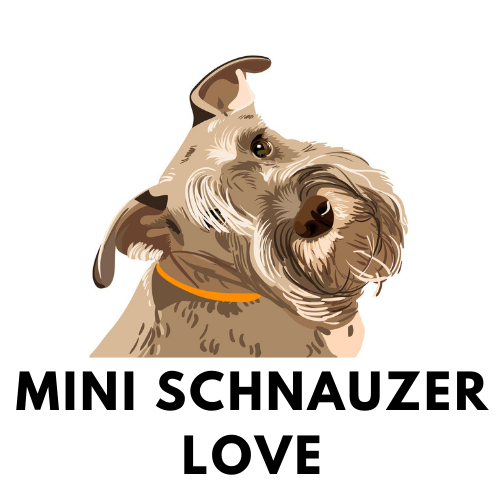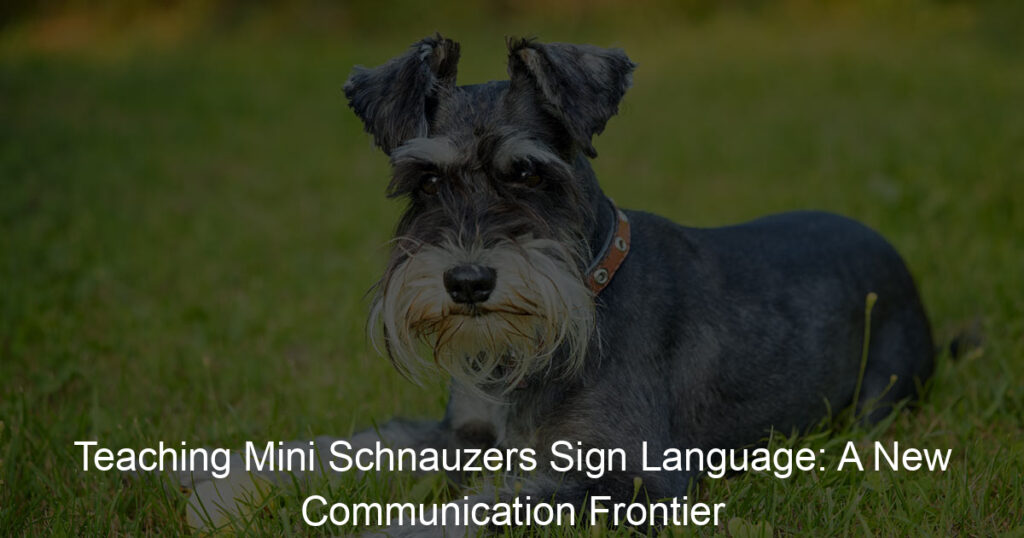
Introduction: Exploring Dog Communication
Communication is the cornerstone of any relationship, and this is no different when it comes to our furry friends. Dogs, like humans, have their unique ways of expressing their feelings, needs, and desires. This introduction will explore the fascinating world of dog communication, with a particular focus on Mini Schnauzers and the possibility of teaching them sign language.
- Understanding the importance of communication with Mini Schnauzers
- Can dogs learn sign language?
Mini Schnauzers, known for their energetic and friendly nature, are a breed that thrives on interaction. They are intelligent dogs that respond well to training and communication. Understanding their signals and being able to communicate effectively with them can significantly improve the bond between you and your pet.
For instance, a wagging tail usually indicates happiness, while a lowered tail might indicate fear or submission. Ears pinned back can be a sign of anxiety, while a relaxed, open mouth can show that your Mini Schnauzer is comfortable and content. Recognizing these signals can help you respond appropriately to your pet’s needs, making them feel understood and secure.
Many people might be surprised to learn that dogs can indeed learn sign language. Dogs are incredibly observant and are excellent at picking up on visual cues. This ability makes them prime candidates for learning sign language, especially for commands and instructions.
Teaching your dog sign language can be a rewarding experience. It can provide a unique way for you to communicate with your pet, especially in situations where verbal commands might not be effective. For example, if your dog is at a distance, or in a noisy environment, a visual sign might be more noticeable than a spoken command.
In the following sections, we will delve deeper into the specifics of training Mini Schnauzers in sign language, including a case study of a Mini Schnauzer successfully learning sign language. We will also discuss the benefits of sign language in dog communication and conclude with a look at this new frontier in pet communication.
Mini Schnauzers Training: Basic Sign Language for Dogs
Training your Mini Schnauzer using sign language can be an exciting and rewarding experience. It not only enhances communication but also strengthens the bond between you and your furry friend. Let’s start with the basics.
Starting with the Basics
Before we dive into the actual training, it’s essential to understand the concept of sign language and how it applies to dogs. Then, we’ll move on to teaching the first sign, ‘Sit’, and gradually progress to more complex signs.
- Understanding the concept of sign language
- Teaching the first sign: Sit
- Progressing to more complex signs
Sign language for dogs is a non-verbal method of communication that uses hand gestures to convey commands or messages. Dogs are naturally good at reading body language, making sign language an effective way to communicate with them. It’s similar to how humans use sign language to communicate with those who have hearing impairments.
Start with a simple command like ‘Sit’. Hold a treat in your hand and raise it above your dog’s head. As your dog looks up to follow the treat, his bottom will naturally go down into a sitting position. As soon as he sits, make a specific hand sign, like a flat palm facing up, and say ‘Sit’. Reward your dog with the treat and praise him. Repeat this process until your dog associates the hand sign with the action of sitting.
Once your Mini Schnauzer has mastered the ‘Sit’ command, you can move on to more complex signs. Remember, consistency is key. Always use the same sign for a specific command. It might take some time, but with patience and practice, your dog will start responding to your hand signals.
Training your Mini Schnauzer using sign language can be a fun and rewarding process. It not only enhances communication but also strengthens the bond between you and your furry friend. Remember, patience and consistency are key. Happy training!
Advanced Training: Sign Language Commands for Dogs
After mastering the basics, it’s time to move on to more advanced sign language commands for your dog. These commands will help you communicate more effectively with your furry friend, enhancing your bond and improving their behavior.
- Teaching the sign for ‘Stay’
- Introducing the sign for ‘Come’
- Teaching the sign for ‘Eat’
The sign for ‘Stay’ is crucial for your dog’s safety. Start by standing in front of your dog with your palm facing them. This sign mimics a stop sign, which is easy for dogs to understand. Practice this command in a quiet environment first, gradually introducing distractions as your dog becomes more comfortable with the sign.
The sign for ‘Come’ is another essential command. To teach this sign, extend your arm and hand straight out in front of you, then pull it towards your body. This motion should mimic the action of beckoning someone towards you. Remember to reward your dog when they respond correctly to reinforce the behavior.
The sign for ‘Eat’ can be useful, especially during meal times. To teach this sign, make a motion as if you’re eating from your hand. Practice this sign before feeding times so your dog associates the sign with the action of eating. Be patient and consistent in your training for the best results.
Teaching your dog sign language commands can be a rewarding experience. It not only improves communication but also stimulates your dog’s mental abilities. Remember, the key to successful training is patience, consistency, and positive reinforcement.
| Command | Sign |
|---|---|
| Stay | Stand in front of your dog with your palm facing them |
| Come | Extend your arm and hand straight out in front of you, then pull it towards your body |
| Eat | Make a motion as if you’re eating from your hand |
Case Study: Teaching Sign Language to Mini Schnauzers
Let’s delve into two real-life examples of Mini Schnauzers who have successfully learned sign language. These case studies will provide a deeper understanding of the process and benefits of teaching sign language to dogs.
-
Case Study 1: Max, the Mini Schnauzer
Max is a lively 3-year-old Mini Schnauzer. His owner, Jane, decided to teach him sign language after noticing that Max was showing signs of hearing loss. Jane started with simple signs like ‘sit’, ‘stay’, and ‘come’. She would use the signs consistently while also saying the commands out loud.
After a few weeks, Max started to respond to the sign language commands even when Jane didn’t say them out loud. This was a clear indication that Max was learning and understanding the signs. Jane continued to introduce new signs gradually. Today, Max knows over 15 sign language commands and is able to communicate effectively with Jane despite his hearing loss.
-
Case Study 2: Bella, the Mini Schnauzer
Bella is a 2-year-old Mini Schnauzer who was taught sign language as a puppy. Her owner, Mike, wanted to enhance their communication and decided to use sign language as an additional tool. Mike started by associating signs with Bella’s favorite treats and toys. This helped Bella understand that the signs had specific meanings.
Over time, Bella was able to recognize and respond to a wide range of signs. Mike found that Bella was more attentive and responsive when he used sign language. Bella’s story demonstrates that sign language can be a valuable tool for enhancing communication between dogs and their owners, even when the dog does not have any hearing issues.
These case studies highlight the potential of sign language as a communication tool for dogs. With patience and consistency, Mini Schnauzers like Max and Bella can learn to understand and respond to sign language commands, enhancing their ability to communicate with their owners.
Benefits of Sign Language in Dog Communication
Sign language isn’t just for humans. It can also be a powerful tool for communicating with our furry friends, especially Mini Schnauzers. Let’s explore the benefits of using sign language in dog communication.
Enhanced Understanding
One of the key benefits of using sign language with your Mini Schnauzer is that it can significantly enhance your understanding of each other. This is particularly beneficial for dogs who may have hearing impairments or for owners who want to communicate silently with their pets.
- How sign language can improve your bond with your Mini Schnauzer
- Examples of successful communication with Mini Schnauzers using sign language
Sign language can help you communicate more effectively with your Mini Schnauzer, leading to a stronger bond. When you use sign language, you’re communicating in a way that your dog can naturally understand. Dogs are excellent at reading body language, so using signs can make your instructions clearer and easier for your dog to follow. This can lead to less frustration for both of you and a happier, more harmonious relationship.
Many Mini Schnauzer owners have found success using sign language with their pets. For example, one owner taught their Mini Schnauzer the signs for “sit”, “stay”, and “come”. The dog quickly picked up on these signs and was able to respond correctly even when the owner was too far away for the dog to hear verbal commands. Another owner used sign language to teach their Mini Schnauzer to stop barking on command. The dog learned the sign for “quiet” and would stop barking as soon as it saw the sign.
As these examples show, sign language can be a highly effective way to communicate with your Mini Schnauzer. It can improve your bond with your pet and make your interactions more enjoyable and less stressful. So why not give it a try? You might be surprised at how quickly your Mini Schnauzer picks up on your signs and how much smoother your communication becomes.
Increased Safety
One of the most significant benefits of teaching sign language to your Mini Schnauzer is the increased safety it provides. Let’s delve into how sign language can be a lifesaver in dangerous situations and some real-life examples of sign language preventing accidents.
- How sign language can help in dangerous situations
- Examples of sign language preventing accidents
Imagine you’re at a busy park with your Mini Schnauzer. The park is filled with children playing, dogs running around, and people enjoying a sunny day. Suddenly, your dog spots a squirrel and starts running towards the road. In such a situation, calling out to your dog might not work as the noise from the park could drown your voice. But, if your dog understands sign language, a simple hand gesture could stop them in their tracks, preventing a potentially dangerous situation.
There are numerous instances where sign language has helped prevent accidents. For example, a Mini Schnauzer owner named Sarah shared her experience. One day, while out on a walk, Sarah’s dog, Max, started running towards a fast-approaching cyclist. Sarah quickly used a stop sign she had taught Max, and he immediately halted, avoiding a collision. Another example is of a dog named Bella, who was taught the ‘stay’ sign. Bella’s owner, John, used this sign to keep Bella from running onto a slippery surface, preventing a potential injury.
These examples highlight the importance of teaching sign language to your Mini Schnauzer. It’s not just about enhancing communication but also about ensuring their safety in various situations.
Conclusion: A New Communication Frontier
As we conclude our exploration of dog communication, particularly focusing on Mini Schnauzers, it’s clear that we’re stepping into a new frontier. Teaching sign language to our canine companions not only enhances our bond with them but also opens up a whole new world of understanding and interaction.
- Recap of the benefits of teaching sign language to Mini Schnauzers:
- Encouragement for continued exploration of dog communication:
Throughout this blog post, we’ve highlighted the numerous benefits of teaching sign language to Mini Schnauzers. This unique approach to dog communication has been shown to improve their cognitive abilities, reduce frustration, and foster a deeper bond between dogs and their owners. The case study we discussed demonstrated how Mini Schnauzers, with their high intelligence and eagerness to learn, can successfully learn and respond to sign language. This not only enriches their lives but also makes them more adaptable and responsive in various situations.
We encourage all dog owners, not just those with Mini Schnauzers, to continue exploring the fascinating world of dog communication. Whether it’s through sign language, vocal cues, or body language, understanding your dog’s unique way of communicating can significantly enhance your relationship with them. Remember, every step you take towards understanding your dog’s language is a step towards a more fulfilling and harmonious relationship.
As we continue to explore and understand more about dog communication, we’re not just teaching our dogs – we’re also learning from them. This exchange of knowledge and understanding is what makes the journey so rewarding. So, let’s continue to push the boundaries of what we know about dog communication and step boldly into this new frontier together.













